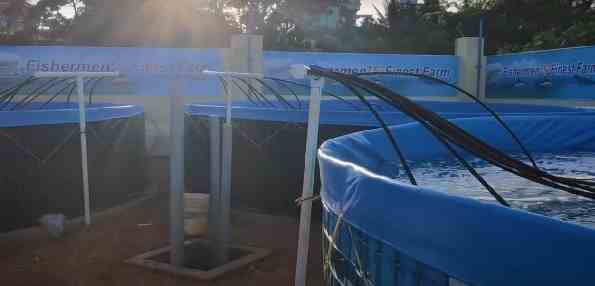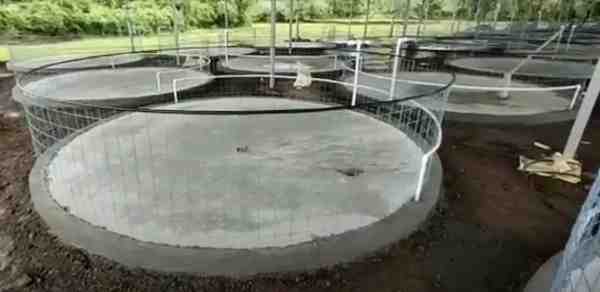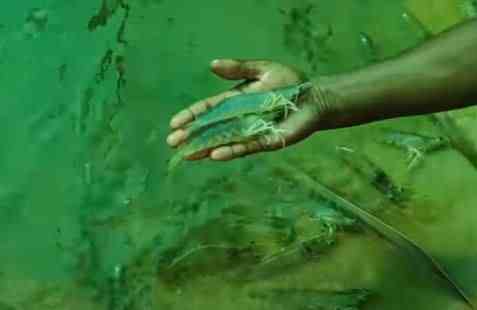11 easy steps biofloc production of shrimp or tilapia
Biofloc fish farming in India, Various Indian states have started using biofloc systems to increase fish/shrimp production, increase quality and maximize income for fish farmers in this process. Odisha Fisheries and Animal Resources recently announced the use of biofloc fish farming technology to boost aquatic life in Odisha.
fish can be produced in high-density artificial tanks biofloc system is an innovative way. It requires much less space than traditional fish farming. According to experts, the four small tanks have enough water supply and an area of 200 to 410 square MS to produce 4000 kg of fish. Different species of freshwater fish such as Tilapia, Carp, Anbas, Magur, Pangasius can be easily reared.
Carbon sources such as probiotics or microorganisms and molasses act on the organic waste in the tank water and convert it into products that serve as food for fish. Odisha is that such systems can be installed on the terraces and backyards of fish producers is a different advantage of biofloc systems Professionally, it can help consumers sell fresh fish directly or to customers.
Officials from Fisheries, Animal Husbandry, Agriculture, Horticulture, and Co-operatives are introducing Biofloc Fish farming technology to farmers in Jammu and Kashmir. High production of biofloc fish farming is a viable option and is beneficial compared to old traditional open pond fish farming.

Similarly, Southern Kerala aims to use biofloc technology for self-sufficient, low cost and environmentally friendly fisheries in biofloc fish farming.
Biofloc of Organica Biotech is a probiotic formulation that contains natural and environmentally friendly bacteria. It effectively breaks down waste and increases the productivity of fish farming, promotes healthy floating, and helps in zero water exchange. Biofloc can help Indian fish farmers improve water quality, prevent disease and maximize production without harming the environment.
According to experts with some of the early developers and adopters of the biofloc, including Shrimp Fish Farming Consultant and experts, Fish Site presents a practical 11-step guide to help you incorporate biofloc principles into your shrimp or tilapia operation.
The most expensive components of aquaculture are the high-quality feeds, the filtration process or methods, and the investment required for the space required to grow the target species. Due to the ever-increasing production costs, farmers and researchers are looking for alternative ways to produce more seafood using fewer resources.
Initially considered as a natural way of clean water, biofloc technology are becoming increasingly popular as a low-cost means of purifying the cultural water of fish and shrimp farms while providing an additional source of the fee. Most importantly, implementing the biofloc principles requires little investment – just as much sunlight, a source of carbohydrates, and plenty of ventilation in biofloc fish farming.
The biofloc technology converts non-feeds, feces, and excess nutrients into food on photosynthesis. once it breaking nitrates, primary-produced autotrophic, toxic ammonia, and heterotrophic bacteria multiply to attract ever-growing hosts – including diatoms, fungi, algae, protozoans, and a variety of plankton. Gently bound to the bacterial mucosa, most of these are floating clamps or “flocs”. The human group may look like brown or green mud through the eyes. Although not very attractive to humans, it is an excellent smorgasbord for making fish and shrimp.
By recycling proteins, biofloc technology overcomes concerns such as higher animal storage densities and lower filtration capacity – such as reduced water quality and the risk of disease outbreaks. In old farming methods, about 20-25 percent of the protein components in feeds are actually used by farmed species. By converting the ammonium used by the filter feeder into a microbial protein, biofloc systems are able to double the figure, saving the farmer big money.
The biofloc system simultaneously reduces the spread and efficiency of pathogens while improving fish health through better water quality and nutritious food availability. In the same way, biofloc systems can give us a natural way to produce more seafood, while at the same time increasing farm profits.
Many shrimp industry players in Asia are moving to biofloc fish farming. the largest prawn business experts, explain: “Without biofloc, our company will not be able to achieve the ambitious growth rate without compromising environmental integrity and animal welfare principles.
It is important to understand that biofloc systems and their basics are relatively new and complex aquatic concepts. Many are still unknown and many more have been discovered. We encourage readers to do more research and share their experiences to maximize everyone’s chances of success. And don’t forget to check out the training reference section at the end of the article for some extremely helpful links.
11 easy steps biofloc production of shrimp or tilapia
Step 1: Set up the tank or pond for biofloc fish farming
While it is possible to convert a traditional fish pond into a biofloc system without any liner, it is a challenging task. Microbes, minerals and heavy metals are naturally ground-based, easily affect pond water parameters, and can affect the internal processes of the biofloc system.
Khoo Eng Wah, managing director of the Sepang Today Aquaculture Center (STAC) in Malaysia, explains the Process. When we receive lots of rainy, the external systems are easily affected by alkalinity and pH. Covered ponds are a good option.”

You can refer to this page if you wish to Interested in biofloc product or materials
Internal tanks or raceways can also be used, but without the existence of natural sunlight, the algae will not grow enough or grow at all – creating a biofloc system based entirely on bacteria. These so-called “brown biofloc systems” are brown in color and will be discussed in more detail later (Step 7).
If you are using large ponds, occasionally drain drains at the bottom to remove excess silt. when adding carbohydrates regularly, which adds more sludge to the pond (step 4). Another option is to use biofloc reactors to accelerate pond sludge conversion into biofluc.
Step 2: Fish feed and Disease management in biofloc fish farming
In the traditional fish farming method, the fish consume very little of the water they are fed. It wastes food and turns it into toxic metabolism. It pollutes the water and spreads its stench to the surrounding environment.
Feed is an essential part of fisheries. Regular feed is required daily for the growth and development of fish. Getting feed is expensive and wasted food is a loss to farmers.
The food wasted in the biofloc fish farming system, as well as the fish excrement in the water ecosystem, are converted into fish feed. Thus the problem of water pollution is solved. Moreover, fishermen save on feed and it is also readily available.
Disease
In open pond fish farming, an expensive water exchange system is used to replace the contaminated water with fresh water. Otherwise, exposure to the disease by exposure to pathogens and toxic organisms and fish causes financial losses to farmers.
Through the biofloc system, probiotics or microorganisms are used that stimulate specific immunity in species such as shrimp and reduce pathogenic bacteria. In addition, water exchange systems and related operating costs are avoided. Thus biofloc fish farming is sustainable and provides maximum productivity. Moreover, it is environmentally friendly and promotes the development of the fishing industry
Step 3: Ventilation for biofloc fish farming
Once you’ve chosen the right pond or tank setup, it’s time to work on the ventilation system. All biofloc systems require a constant speed to maintain both high oxygen levels and to maintain stability in density. Non-moving areas will rapidly lose oxygen and turn into anaerobic zones that release large amounts of ammonia and methane.
To avoid this, every pond, tank or raceway system needs a neat arrangement of aerators. Ponds typically use paddlewheel aerators. The Biofloc system requires 6-7 milligrams of oxygen per liter and it is suggested to start with aerators of at least 30 horsepower per hectare. However, depending on the intensity and productivity of the system, this number can reach up to 200 horsepower per hectare (see Table 1 on Southern Regional Aquatic Centers).
Paddlewheel aerators must be installed strategically to generate current in the pond. You also need to move some aerators regularly to make sure that the solid particles will not remain stable in areas with little or no volume.
Step 4: Species selection and raise in density for biofloc fish farming
Although most species will benefit from the improved water quality of the biofloc systems, you need to choose the species that will benefit the most from the extra protein generated by the biofloc itself by feeding and digestion. These species are whole or partial filter feeders. Shrimp and tilapia are both excellent candidates, in which they are silent on the biofloc, thereby dramatically improving the food efficiency and FCR of your farming activity.

In STAC in Malaysia, even non-filter feeders like jade perch and different groupers have been built into the indoor biofloc system, which has positive results. It is important to avoid confusing water-loving species with high solids, such as some catfish and barbs. These species just won’t work as well.
Thanks to the vigorous ventilation and self-filtering capacity of the culture water, high storage density can be considered and shrimp are common in densities after 150 to 250 larvae per square meter. The safe storage density for tilapia would be 200 to 300 fry per cubic meter. Many farmers try to use higher storage densities but this increases the risk of disease and compromises both the health and well-being of the animals.
Step 5: Pre-seeding beneficial microorganisms in biofloc fish farming
To accelerate the development of your biofloc system and stabilize the pond faster, it is better to pre-seed the culture water. This can be done by adding several commercial or homemade recipes to the culture water. INVE and WinBBO are two well-known companies that provide starter cultures for various probiotic microorganisms, but there are many brands produced locally in Asia (just look at the online forum or Alibaba). A simple homemade recipe for quick preparation of probiotic and prebiotic microorganisms, wheat pollard and red cap 48 (a local product from Southeast Asia) are mixed in a closed drum and left to ferment for 48 hours, after which the ingredients can be added to the pond.
Step 6: Balanced carbon source for biofloc fish farming
We recommend jump-start the growth and development of biofloc in your pond or raceway system by ensuring the availability of carbohydrates to avoid ammonia peaks (mainly arising from nitrogen in feeds) during the farming cycle. To maintaining water quality, carbon from these carbohydrates which enables heterotrophic bacteria to multiply and synthesize ammonia,
We recommend that you choose only carbon sources and feed a mixed carbon-to-nitrogen (C / N) ratio above 10 as this is conducive to the growth of these heterogeneous toxins. Since most fish and shrimp have a C / N ratio of 9/1 or 11: 1, additional inputs are required to increase this ratio between 13: 1 and 14: 1 Any ingredient that breaks down quickly with plain sugar can be used, such as jaggery, cassava, grass, sugarcane or starch. Another solution is to reduce the protein content of the feed used.
To avoid ammonia peaks at a later stage of the production process, this step should be repeated, especially when using high stock densities in combination with large amounts of synthetic feeds.
This is one of the most difficult steps to successfully Controlling and implement biofloc principles.
Step 7: Control and Monitoring of biofloc technology
From this location, it is necessary to monitor the pond water and take water samples regularly, and determine the action of the two biofloc technology types as well as their respective densities. Simply put, the outer biofloc’s contained green algae and brown bacteria: algae mainly use sunlight for their growth, while bacteria mainly use leftover feeds, their by-products, and related wastes.

Since algae initially multiply rapidly, this means that as the bacterial colony begins to dominate, the pond will turn green the next week and turn brown the next week. As stocks increase and feeding increases, a tipping point will be reached in which the water will remain brown. Mr.Taw explains: “This brown color is reached more quickly with tilapia because they are given more feeds, while prawns take a little longer.” This color shift is well illustrated in the color index of Figure 4.
Step 8: Growth of biofloc fish farming
With plenty of ventilation, natural light (in most systems), and a readily available source of carbon, your biofloc needs to increase quickly. Depending on various factors including water temperature, available nutrients, and sunlight, as well as the number of B-bead biofloc technology at the start of the operation, it will increase from zero per milliliter to about four to five units in a few days. Weeks. Eventually, an unparalleled density of 10 billion bacteria per cubic centimeter can be expected, as Nyan Tao says, “there is an incredible diversity in more than 2,000 species,” all working hard to reduce the amount of ammonia in the water column and maintain good water quality. .
To monitor the growth of these people using a cone-shaped beaker to collect water samples from 15 cm to 25 cm preferably in the late morning. Solid particles should be released to stabilize for 20 minutes. They will stick to the sides of the cone-shaped beaker so that they are easy to measure. For large operations, the Mill Kin bacteria counter is a handy tool.
Step 9: Control of water parameters and Monitoring biofloc tank system
Once the biofloc system has turned brown, ventilation must be significantly increased to maintain a high respiration rate. As shown in Figure 4, respiration at this stage can reach 6 milligrams per liter per hour, which requires six times more energy per hectare than when the operation begins.
Any power failure at this stage due to lack of oxygen can lead to failure of the entire crop and because of the lack of oxygen, many heterogeneous bacteria begin to produce ammonia. Ventilation systems must always be functional.
This means maintaining and maintaining its own air carriers, as well as an energy system that provides the energy to run the system. Since the power grid is not very reliable in many Asian countries, especially in rural areas where a lot of farming is done, farmers are advised to invest in off-grid solutions. Many manufacturers of paddlewheel aerators run on solar energy. These however are more expensive and not always powerful. A large diesel generator, with a backup generator set, may be the best option for most large farm operations.
Regular monitoring of water quality parameters, especially dissolved oxygen and ammonia levels, will give you a better idea of if the system is working well or if ventilation needs to be further enhanced.
Step 10: Monitoring and control of pond stocks in biofloc system
In addition to maintaining water quality at a low cost and without water exchange, another goal of biofloc technology is to improve growth rates and feeding efficiency, thereby improving the profitability and sustainability of farm operations.
To check how farming is doing, regular monitoring of farm stock performance, measuring and recording growth rates, overall views, FCR, and stock survival is essential. It has been estimated that the feed for each component of the increase in your stock can increase from 0.25 to 0.5 units of growth from the biofloc technology in your system. Just make a note of it while comparing current farming methods with your previous, traditional non-biofloc farm operations
Step 11: Harvesting and cleaning in biofloc technology
For prawns, a crop of 20 to 25 tons per hectare is safely expected. If all the steps are followed, the farmer can expect growth rate and survival, which will reduce overhead costs and increase profits.
Often forgotten and under-written, proper cleaning and arrangement of ponds or raceways is required after harvest time. Although it calls for the recycling of culture water due to intensive efforts to increase the microbial population, this is not fair. Pathogens may have created this culture and this could pose a serious threat to bio-safety. Research has also suggested that over time, heavy metals can form in cultured water, which can accumulate in our reserves and make them unfit for human consumption. We recommend good cleaning before starting your next beneficial batch.
Don’t forget to follow the Fish site to keep up to date with the latest developments in the industry!
Training, and you can read more about
This step-by-step guide has been simplified, so we encourage you to do more research. For those looking to purchase an entire encyclopedia on Biofloc, Dr. Samocha has recently published a new book, Sustainable biofloc technology for Marine Shrimp. Another excellent source we used as a reference for this publication is this article by John Hagrives of the Southern Regional Aquatic Center on the topic “Bio-flock production systems for aquatic life”